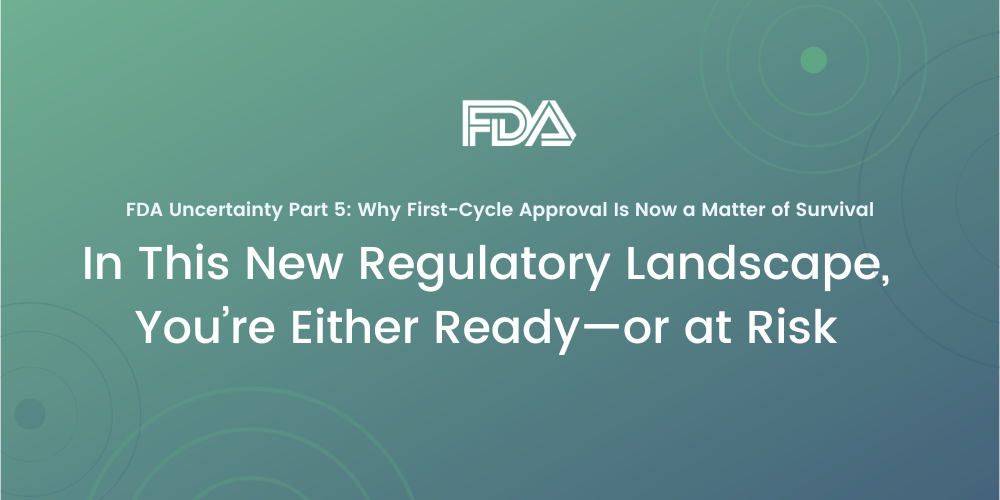In This New Regulatory Landscape, You’re Either Ready—or at Risk
FDA Uncertainty: Why First-Cycle Approval Is Now a Matter of Survival Leadership shake-ups, budget...
read Details

The integrity of supply chain management is pivotal in the demanding realm of the pharmaceutical industry. This two-part article series explores Supply Chain Process Validation, addressing the multifaceted challenges and evolving demands professionals like yourself face in ensuring product integrity from manufacturing to delivery. Amidst economic, technological, and regulatory pressures, the series begins with an overview of the supply chain validation process, emphasizing the need for comprehensive strategies to navigate competing priorities, sustainability initiatives, and the globalization of supply chains.
The series continues with the critical aspects of supply chain management, from integrating management systems and developing mature quality systems for qualifying and validating equipment and processes essential for maintaining product quality. Each article builds upon the last, offering a detailed examination of operational qualification and the significance of performance qualification in affirming the effectiveness of supply chain management practices. The series encapsulates the essential elements required for a robust, compliant, and efficient supply chain, underscoring the importance of a lifecycle approach to process validation, integration of logistics, and innovative technologies.
Central to this comprehensive guide is the expertise of Modality Solutions, a frontrunner in supply chain management solutions for the pharmaceutical industry. Modality Solutions excels in navigating the complexities of the supply chain, providing invaluable insights into engineering, regulatory compliance, and quality assurance. Our proficiency and innovative approaches empower your company to enhance your supply chain systems, ensuring regulatory compliance, operational excellence, and the safe transport of products.
The series highlights the challenges faced by supply chain management professionals and showcases Modality Solutions’ commitment to delivering state-of-the-art solutions. We carve a path to achieving a compliant and efficient supply chain through practical examples and expert insights. Modality Solutions’ focus on simplifying complex supply chain processes translates into confidence for our clients, guaranteeing the integrity and quality of pharmaceutical products throughout your journey to the patient.
Supply Chain Management Challenges
Competing priorities, changing expectations, cost pressures, sustainability initiatives, and emerging markets are some of the challenges facing supply chain management professionals every day. Solutions that deliver value in the supply chain and enhance your regulatory reputation are required every day, around the globe. Today, engineers and manufacturers face economic and regulatory pressures, accelerating costs, technology changes, and the need to constantly adapt their business models. The advent of more widely distributed supply chains and other influences demand greater investment in tools, expertise, and, most importantly, human capital.
Investment in these mediums is needed to rise above some of the toughest challenges:
As the pharmaceutical industry become global, more API (Active Pharmaceutical Ingredient), Drug Substance (DS), and drug products (DP) are being manufactured in one region and transported/imported/exported to other regions around the globe. As a result, supply chain safety and validation are becoming much more critical. Third-party logistics (3PL) partners are increasingly involved in product handling, storage, and distribution. This includes contract manufacturers, repackaging companies, wholesalers, distributors, hospitals, mail delivery and distribution companies, retail pharmacies, logistics companies, freight companies, etc. Other areas that should be included are warehouses, intermediate/temporary storage and transportation areas, operation vehicles, transportation cabins, containers, trucks/automobiles/emergency vehicles, rail cars, ships, etc.
All links along the pharmaceutical supply chain must ensure that product handling, storage, transportation, and distribution are performed appropriately for shock and vibration, temperature, humidity, light, and other relevant environmental conditions. Adequate control and monitoring for these conditions should be established and validated to assure product quality.
Temperature and Relative Humidity-Controlled Transportation Products
Temperature and relative humidity-controlled transportation products require special temperature, relative humidity handling, and equipment usage during storage, transportation, and distribution. These products may be shipped outside their official storage conditions, only based on approved stability data or other scientific/technical justification that product quality will not be affected from product manufacturing until arrival at patients.
The US FDA, EMEA, ICH, and a host of other organizations have issued guidance documents on principles of process validation. However, most do not address transport issues specifically. The requirement to validate all critical-to-quality processes remains. There are new approaches to answer these questions on how transport networks can be validated.
Supply Chain Transportation
Supply chain transportation can be validated just like any other process. Process validation aims to create a robust process that consistently produces product with minimal variation. The same goal is set for your distribution processes. By applying good validation principles to your distribution processes, you can validate your transport process. This approach requires qualified packaging and equipment (e.g., over-the-road trucks, active refrigeration units, etc.) and a new approach to process definition for your supply chain transportation network.
Pharmaceutical supply chain excellence starts by integrating your supply chain. By integrating your supply chain, you ensure that all the processes work together to achieve a common goal – to deliver quality medicines to the patients who need them.
What Systems Encompass an Integrated Supply Chain Management System?
A compliant supply chain management system is composed of various components working in concert. An integrated supply chain management system will ensure control of the distribution chain and consequently maintain the quality and integrity of products. These processes working together can produce consistency within the transport process, which allows the transport network to be validated.
The seven components are:
The appropriate tools, expertise, and experience are critical when coordinating your activities to ensure safety, safeguard quality, and maintain regulatory compliance. These measures must also be used to prevent falsified, adulterated, and counterfeit products from entering the legal supply chain.
Modality Solutions ensures compliance with these regulations by providing the following services:
You get results by focusing on implementation, not just defining regulatory requirements. A properly integrated supply chain ensures regulatory compliance, product quality, and patient safety. This provides a multi-layered approach that combines best practices of process validation, systems qualification, and risk assessment with the most applicable monitoring and controls for qualified packaging.
Developing mature quality systems is one of the biggest challenges and one of the most effective tools to manage a world-class supply chain logistics network. Making them work for you, and not the other way around, is key to your success. At their best, quality systems establish, implement, and maintain a set of processes to provide the highest quality service to customers, the highest level of effectiveness for management, and the most robust compliance approach for regulators.
At their worst, they get in the way, adding only administrative burden and redundant reviews to an already complex and fast-moving network. The value of an effective quality system that facilitates continual improvement cannot be overstated compared to an ineffectual system that only provides delays, derailments, and disasters.
An effective guide is needed to thoroughly review your quality management system processes and tools to identify opportunities to provide structure and clarity to assist in the continual improvement of your controlled-environment logistics network. A review of the following elements of your quality systems should ensure these foundational capabilities are in place for your supply chain:
Quality Manual, Standards, and SOPs
A review of your quality system structure focused on regulatory requirements, best practices, and ease of use. Match the size and complexity of the activities you manage to the complexity of your documentation.
Good Documentation Practices
Standardized templates, revision controls, and approval signatures are the cornerstones of an effective quality management system. Implementing the appropriate practices for your technical documents, protocols, and reports is required for a successful audit.
NCs and Exception Management
Non-conformances (NCs) and exception management are uncomfortable realities in a global controlled-environment logistics network. Properly documenting non-conformances and effectively managing and documenting exceptions requires a well-defined and streamlined approach. Handling NCs is key to continual improvement, coupled with an effective management review.
CAPA and Change Control
The procedures for implementing corrective and preventative action (CAPA) that help analyze processes, operations, records, complaints, and other sources of data to confirm root causes serve as one of the main roles of quality systems. A robust CAPA process uses appropriate statistical methods to identify trends and reoccurring non-conformances and provides investigational procedures to follow. Controlling change in your organization, identifying a planned approach to CAPA resolution, and including effectiveness verification, is necessary to drive continuous improvement.
Management Review
Any quality system needs management support to enact change. A management review process requires identification of key performance indicators with process control limits in place to determine when action is required. Self-assessments, audits, and guideposts provide the essential feedback loop built into your quality systems for the executive team to understand quality failures, process needs, and updates on improvements.
Use these tools to assess your capabilities, create time-bound improvement plans, and mentor your team on the opportunities for improved profitability and efficiency. Conducting a quality systems maturity assessment can lead the way to breakthrough performance.
The pharmaceutical supply chain network is complex, but Modality Solutions makes it easy to simplify and streamline your supply chain. Working as a professional in the supply chain network means facing daily challenges. Just because the pharmaceutical supply chain network is complex doesn’t mean that your management system must be. Let our focused pharmaceutical supply chain engineering firm deliver results with our advanced technology and world-class engineers. Contact us today.
Here’s what you can expect:
FDA Uncertainty: Why First-Cycle Approval Is Now a Matter of Survival Leadership shake-ups, budget...
read Details
FDA Uncertainty: Why First-Cycle Approval Is Now a Matter of Survival Leadership shake-ups, budget...
read Details
FDA Uncertainty: Why First-Cycle Approval Is Now a Matter of Survival Leadership shake-ups, budget...
read Details